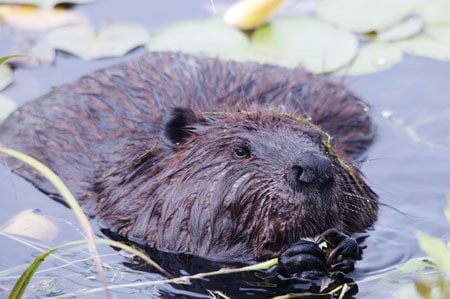A keystone species at work in the watershed

The North American beaver (Castor canadensis) is enjoying a time of relative prosperity in the United States, a significant feat given the beaver was driven to near extinction by the start of the nineteenth century. An insatiable European demand for beaver pelts to make fashionable clothes and hats fueled the North American Fur Trade in the seventeenth and eighteen centuries, when French, English, and American fur trappers harvested beavers in incredible numbers.
Here in Michigan, demand for beaver pelts played a crucial role in European colonization of the territory. French fur trappers were among the first white people to push west into the Great Lakes Region and the lands of the greater Anishinaabe peoples. Forts at Detroit, Mackinac, and elsewhere across the territory allowed the French to establish control over the lucrative fur trade, the primary economic driver at the time. As fashions changed and the demand for beaver pelts waned, the fur trade ended; yet remaining beaver populations faced a continued battle with polluted waterways and habitat decline.
However, with the help of conservation efforts and environmental protections, this industrious rodent has made a comeback across the U.S., including right here in the Huron River watershed.
Rodent, you say?
Yes! Beavers are one of the largest rodents in the world, second only to the capybara of South America. The two species of beaver alive today are the closely related Eurasian (Castor fiber) and North American beavers, both of which can weigh up to 70 pounds and reach three feet in length. A semi-aquatic animal, beavers spend most of their time in the water and have developed a number of adaptations to succeed in aquatic environments. Beaver fur is naturally oily and water repellent – one of the many reasons beaver pelts were so prized both by Native Americans and early Europeans. Beavers can hold their breath for fifteen minutes underwater and have a set of transparent eyelids that serve as goggles – they also have webbed feet ideal for paddling and their flat tail helps the beaver maneuver through the water like a rudder on a boat. Beavers are active all winter long even when ponds and rivers freeze over, as they can swim long distances beneath the ice and their thick coats keep them warm even in the coldest of water.
Beavers are known as ecosystem engineers. Their construction of dams in rivers and creeks can significantly affect regional hydrology and habitat. Beavers build dams by felling trees with their large front teeth. They weave tree trunks, branches, and twigs together to create a latticework wall that they waterproof with mud. Beavers use their powerful, flat tails to slap the mud into place, binding the logs together like mortar on a house. Behind the dam, water pools upstream transforming stretches of river into ponds. In the calm waters of the pond, beavers build lodges to live in. The pond provides protection from predators, a place to forage for food, and still water to float logs and other building supplies to their construction projects.
Ecosystem benefits
Flooding caused by beaver dams creates a diverse array of habitats that support insects, waterfowl, fish, and amphibians. For this reason, beavers are also considered a keystone species because their presence in an area can enhance biodiversity and promote the success of other plants and animals in the ecosystem. Beaver dams provide other benefits to ecosystems such as erosion control and pollution filtration. Slower flow, coupled with higher water levels upstream, allow pollutants to be filtered slowly through vegetation and breakdown over time. This slower flow also prevents excess sediments from washing into the creek, which can harm aquatic species and contain fertilizers and other chemical contaminants.
Beaver dams provide downstream benefits as well. The ponds provide a steady supply of water to downstream reaches in dry periods, as water stored upstream of the dam in rainier seasons is released slowly over time. Such changes to river hydrology and the local landscape can occur rapidly when there are beavers present―the “busy beaver” as they say, can build a dam overnight!
A nuisance to some
Despite the beaver’s contributions to ecosystem diversity, beavers are considered a nuisance in some places. Beaver dams can cause flooding and damage to homes, businesses, and roads. In some small creeks, dams can cut downstream flow to a trickle. Historically, “problem” beavers were exterminated. However, these days efforts are often made to relocate beavers to natural areas where their dam building can contribute to the diversity and vibrancy of our local ecosystems. In the Huron River watershed, beavers are currently very active in Hudson Mills Metropark along the Huron River, where the results of their tree felling are apparent near the walking path. HRWC has also received reports of beavers near Burns-Stokes Preserve, Huron Meadows Metropark, on the river in Huron Township, and in Wixom Habitat Park (Norton Creek, Oakland County). It is exciting to see this iconic rodent back at it in the Huron. An integral part of Michigan’s past, the beaver is once again a part of the watershed’s bright future.



